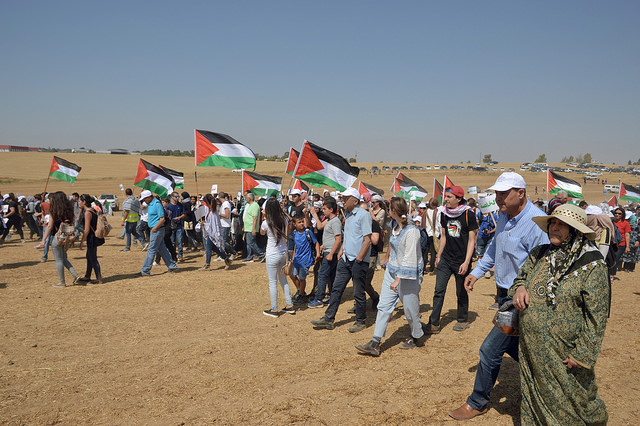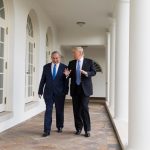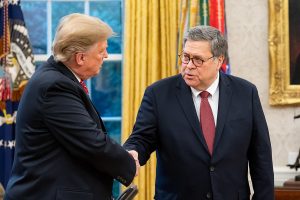by Colter Louwerse
It is no modest feat that Gaza’s Great March of Return and the End of the Blockade now arguably claims the mantle of being the longest ongoing mass protest movement on the planet. On every Friday for over a year, tens of thousands of men, women, and children have desperately sought to draw international attention to their plight by approaching Gaza’s Israeli-controlled perimeter fence en-masse.
The people of Gaza have undertaken this initiative at monumental personal cost. Israel’s response has been as incontrovertibly murderous as the protests are largely nonviolent. Human rights organizations have chronicled the tens of thousands of injuries inflicted by Israeli Defense Forces (IDF) live fire, while a United Nations fact-finding mission of all 189 fatalities in 2018 concluded that—with the “possible exception” of two isolated cases—“the use of live ammunition by Israeli security forces against demonstrators was unlawful”.
The wretched source of the protesters’ grievance is equally incontrovertible. Forcibly enclosed by Israel within a ghetto-like territory deemed by the UN to be “unlivable”, where 97% of the tap water is contaminated, 80% of the population is below the poverty line, and 1.3 million people are now food insecure, many Gazans prefer risking indiscriminate death at the fence to a soul-crushing life subject to unrelenting economic and ideological strangulation.
Yet despite Gaza’s great venture, a year has passed and neither of movement’s two goals—to lift the illegal Israeli blockade and to actualize the right of Palestinian refugees to return to their homes inside of Israel proper—have been accomplished. Impressive as the demonstrations are, the uncomfortable question lingers: Why haven’t they succeeded?
Part of the answer lies in the highly effective architecture of occupation Israel has crafted in order to maximize its domination of the Palestinians while minimizing the costs of sustaining it.
A History of Suppression
Israel has a long history of crushing all forms of Palestinian resistance, and the current anatomy of the occupation is in large part the product of lessons well learned over the past half-century. Most notable is the period from 1987-1990, when the IDF was tasked with the forcible suppression of the first Palestinian intifada, a mass nonviolent movement aimed at independent statehood that rapidly ignited every corner of the occupied territories.
Perhaps counterintuitively, political leverage, not moral persuasion, is the lifeblood of a nonviolent self-determination movement. Exercising this requires dimensions both internal and external to the territory. Internally, pressure is exerted by withholding the consent necessary for the perpetuation of the status quo. Externally, it is exerted by sufficiently mobilizing international outrage in order to inflict costly sanctions upon the occupying power. The nature of the Israeli occupation in 1988 lent the intifada ripe opportunity for both.
In 1987, the IDF was deployed within the Gaza Strip with a dual objective to protect illegal Jewish settlements established in the territory and to directly control the indigenous population. As such, when the intifada broke out there were myriad potential sites of resistance available to the resurgent Palestinian masses, and not nearly enough soldiers to police them all. Israeli soldiers were known to forcibly disperse stone-throwing Palestinian youths on one street, only to have the whole process repeat after encountering the same youths on the next street over. Logging some 200,000 incidents of nonviolent protest between 1987 and 1992, the Israeli military was forced to mobilize its reserves in order to continuously reconquer and hold territory from the galvanized indigenous population. Moreover, the interlinked Palestinian-Israeli economies meant that mass demonstrations in the streets were buttressed by numerous indirect methods of resistance, including general strikes, refusal to pay taxes, and boycotts of Israeli products.
Israel’s brutal response to internal Palestinian pressure only stoked mounting external pressure to end the occupation. Defense Minister Yitzhak Rabin’s “Iron Fist” policy of unbridled beatings, deportations, and systematic torture of Palestinian civilians shredded Israel’s claim to being a benign ‘liberal occupier’, elicited international outrage, and increased support for the intifada’s demands.
The intifada ultimately failed to shake the IDF’s vice-like grip on the occupied territories, but it did prompt Israel to strategically remodel its methods of domination. Having sunk great physical and political costs into suppressing the Palestinian masses, Israeli policymakers now sought to put strategic distance between the occupier and the occupied. In doing so, they frustrated both Palestinian and international pressure upon Israel to end the occupation and accept the international consensus on a two-state settlement.
Starting in the 1990’s Israel gave up on policing Gaza and began to physically and economically decouple from the territory. This process was completed in 2005, when Israel withdrew its settlers and military from Gaza before subjecting the enclave to a crippling and illegal blockade. In doing so Israel established an occupation by remote-control, retaining control over the Strip’s borders, airspace, waters and peoples registry but otherwise severing itself from the Palestinian population. The effect was to place Gazans in the exceptional circumstance of being an occupied people whose only viable method of confronting the occupier is by directing their resistance outside of the territory they inhabit.
Suppression At a Distance
Having unilaterally limited the zone of direct engagement with Gazans to a single perimeter, Israel now suppresses nonviolent protests on its own terms, with its snipers comfortably positioned to target unarmed demonstrators from a great distance.
Disrupting the methodical work of the soldiers is almost impossible. As detailed in the 2019 report of the United Nations Commission of Inquiry, to reach a soldier at a main protest site a demonstrator must traverse over 200 meters of open terrain, navigate beyond a series of barbed wire coils creating a de-facto no-go zone on the Palestinian side of the barrier, scale or cut through a 3-4 metre tall fence, cross two patrolled roads, bypass additional barbed wire, and scale metres high sand berms upon which the IDF soldiers are perched, all the while avoiding the crosshairs of dozens of highly trained snipers. On the first anniversary of the protests, demonstrators had to contend with yet another obstacle—cowed by Israeli threats to cut off the trickle of aid that it allows into the strip, Hamas deployed hundreds of observers wearing orange vests tasked with preventing protesters from approaching the barrier.
No wonder then that, in the course of a year of demonstrations, a grand total of four Israeli soldiers have been lightly to moderately injured—an imperceptible price to pay for inflicting life-changing injuries and death upon thousands of unarmed people.
Moreover, Israel’s total separation from the Gazan economy has rendered strikes, tax resistance and boycotts—strategic pillars of the first intifada—completely impotent. Even the cost of staving off imminent humanitarian collapse in Gaza has been outsourced to European states and NGOs, which now provide essential aid to the territory whilst dutifully footing the reconstruction bill every time Israel devastates the Strip during its regularized military operations.
The geographic separation of Gaza from the West Bank has additionally benefited Israel by accentuating internal Palestinian political fragmentation. Today, Israel has effectively offloaded the job of suppressing occupied Palestinians to their own leadership. With U.S. assistance, the Oslo Accords enabled Israel to transform the Palestinian Liberation Organization from a principled resistance organization into an acquiescent and corrupt administrator of the occupied territories. While the Palestinian Authority no longer has a presence in Gaza, its loathing of Hamas, ongoing collaboration with Israel on ‘security’ matters, and fear that the reemergence of a genuine Palestinian mass-movement would displace it in favor of a leadership with stronger nationalist credentials, has led it to repeatedly stymie the protests’ spread into the West Bank.
Finally, this new geopolitical configuration has contributed to Israel’s presentation of its Gaza policy as one of defending a border against hostile foreigners, an image far more assimilable to international (particularly Western) audiences than the reality of brutally suppressing a nonviolent self-determination movement.
This is rendered all the more convincing by Israel’s strategic decision to contain, rather than eliminate, Hamas in Gaza. Regardless of the increasing moderation of the Islamist organization and its recurrent willingness to accept and uphold ceasefires, Hamas’ proscription as a terrorist organization by the US and the European Union has allowed Israel to exploit it as a perennial bogeyman. No matter how ‘pure’ the nonviolent methods and ends of the protests, the undying spectre of Hamas terror has enabled Israel to inhibit the moral clarity requisite for effective international action.
Whilst occasionally punctuated by outraged condemnation of Israel’s bloody legacy in Gaza, Western states have consistently veiled their unwillingness to act behind platitudinal calls for “both sides” to refrain from violence and pleas to “restore calm”.
Of course, not all the blame can be attributed to the calculated evolution of Israel’s occupation apparatus. It bears noting that the usual centers of Western solidarity with Palestine have mobilized too little, too late. The current extent of international apathy towards Palestinian nonviolence is exemplified by these lamentable facts: during the first six weeks of the Gaza protests, not a single major demonstration in solidarity was held in New York, while an isolated demonstration in London attracted a miserly 2000 people.
If the Great March of Return has failed to accomplish its ultimate goals, it is not for lack of Palestinian courage or effort. In waging a nonviolent war against Israel’s occupation, the people of Gaza have re-asserted their existence upon the world stage. The ball is now in the court of Palestine’s international allies. Only a renewed and urgent activism can pierce the moral haze that cloaks Gaza’s martyrdom and compel the international community to armour Palestine’s inhabitants against the hail of Israeli live fire. The Great March has just now begun to dwindle. Its death would mark a dark stain on the record of those who claim to support it.
Colter Louwerse is a Ph.D. researcher in Palestine Studies at the University of Exeter.






This article doesn’t examine the responsibility of the murderous, corrupt and undemocratic leadership of the Palestinians as an element of this analysis. It therefore lacks any balanced credibility. Moreover, documented violence related to the intifada and marches has been conveniently ignored. This paper is juvenile.
They have not and cannot succeed, because they stand against the Almighty God of israel, just as thousands of years ago Goliath the philistine tried to withstand David the Shepherd boy, and therefore tried to stand against the Almighty God of israel………and we all know how that ended.
You also fail to state many facts in order to make the Israel’s look as barbaric as possible. This article is completely biased, unbalanced, and one sided, and you have chosen your side. You are totally biased towards a people who commit murder, and mayhem to the general Israeli population at any cost, and are treated as heros by their own leadership
You fail to mention anywhere in your article that there is another fence to the east. It’s called the blockade to Egypt, another Arab country. I wonder why you omitted that important fact? One may wonder why there is a blockade to another Arab brethren state?
Peaceful protesters with fiery balloon kites which start fires all over southern Israel. Oh, that’s right, your article states these are simply peaceful protests to the world’s model citizens.
Hamas, their terrorist elected leadership, what about their charter? It is written that they will never rest until Israel is destroyed by any and all means necessary. Oh, I see you again conveniently fail to mention any of that.
Their elected leaders do more damage to own people than anything Israel has ever done to them. That is a fact, and not an opinion.
When Israel pulled out of Gaza back in 2006, they left the people of Gaza, an amazing array of greenhouses filled with plants, flowers, and fruit trees to farm and cultivate. Of course you would never mention any of this. Do you know what became of those greenhouses today? They use them to store rockets to lob over to Israel with today. Again, such a peaceful lot of folks they are. They have sent thousands of rockets into Israel with no guidance systems that discriminately hit wherever they hit, schools, homes, and hospitals be dammed.
It has been said that the Palestinian’s never an opportunity to miss an opportunity.
Golda Meir once said: T”will be peace one day when the Palestinian’s learn to love their children more than they hate us.”
She also said this: “I can forgive the Palestinian’s for killing our children, however I cannot forgive them for making us kill theirs.”
Keep your one sided bias reporting going to smear Israel as best as you can, facts be dammed. It seems to be working for you. It seems to suit your agenda.
Who writes that kind of antisemitic propaganda and doesn’t even bother to keep a semblance of truthfulness? The name of this blog should be renamed:LIBLE BLOG. You do not help the Palestinian people get recognition or a better life by going for the Jewush jugular ad nauseam, ad infinitum . Get a life, tell the truth, create a chance for peace. The light always wins. Israel is the light, you are the pitch black darkness.
First of all this activity didn’t succeed because it was doomed from the start. Shortly after it started, Sinwar gave an interview where he stated the “great march” was just a ploy to take the heat off Hamas for the poor conditions in the strip. Secondly there was more going on here than protesting. While most of those who showed up could be considered “protesters” many others, mainly Hamas operatives, incited the crowd to riot, throwing grenades, sniping at soldiers, planting bombs and sending over incendiary devices, not to mention damaging the fence while trying to get into Israel. It was mainly these folks that got killed and injured and Hamas acknowledged that most were their operatives. Crowds numbering up to tens of thousands that suddenly turn to rioting are not easily stopped, even if the majority are not armed. After the first few weeks, the people of Gaza knew full well what to expect from the IDF if they took to violent means as I described, yet they chose to keep showing up for more than a year. They had a choice not to show up at the border and be safe, the IDF had no choice because they had to be at the border to protect the citizens.